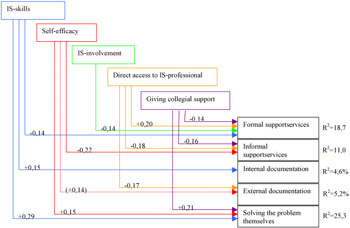Results
|
|
The various sets of variables that are included in this survey have gone through factor analysis, to filter unwanted items that do not measure the variables well enough. Through convergent and divergent validity analysis some items were rejected. This was to ensure the lack of non-redundant concepts.
The results from the analysis supports the following hypothesises: H1a, H1c, H1e, H2b, H2d, H2e and H3a. In addition, direct access to IS-professionals seems to correlate positively with the use of formal support services, negatively with the use of informal support services and negatively with the use of external documentation. Also, giving collegial support correlates negatively with the use of both formal and informal support services and positively with the added dependent variable solving the problem themselves. Figure 2 summarizes the results of the analysis.

Figure 2: Summarizing the Results
The beta (multiple regression) values that are indicated along the arrows apply to the covariance after the inclusion of the control variables. The dashed arrow between Computer Self Efficacy and External Documentation point out there was covariance between the two variables, but this covariance disappeared when the control variables was accounted for. R2 states explained variance in the dependent variable(s).
|
|
EAN: 2147483647
Pages: 186